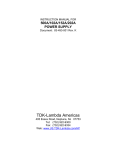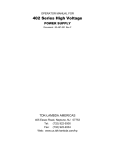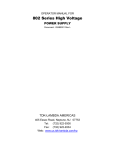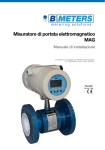Download Fluke pmn Power Supply User Manual
Transcript
INSTRUCTION MANUAL FOR 83-493-001 Revision G MODEL SERIAL NUMBER 405 ESSEX ROAD, NEPTUNE, NJ 07753 TEL: (732) 922-9300 FAX: (732) 922-9334 Table of Contents 1 INTRODUCTION 1.1 Description 2 SPECIFICATIONS 2.1 Average Charging Rate 2.2 Peak Charging Rate 2.3 Number of Models in Series 2.4 Standard Voltage Ranges 2.4.1 Linearity 2.4.2 Accuracy 2.5 Polarity 2.6 High Voltage Assembly 2.7 Input Connector 2.8 Input Chart 2.9 Power Factor 2.10 Efficiency 2.11 Stored Energy 2.12 Stability 2.13 Pulse To Pulse Repeatability 2.14 Temperature Coefficient 2.15 Ambient Temperature 2.16 Humidity 2.17 Protection 2.18 Agency Approvals 2.19 Transient Line Protection 2.20 ESD 2.21 Note for PFC Units 2.22 Accessories 2.23 Options 2.23.1 Suffix -SYS 2.23.2 Suffix -RFI 2.23.3 Suffix -LH 2.23.4 Suffix -EN 2.23.5 Suffix -5V 2.23.6 Suffix -LP 2.23.7 Suffix -110 2.24 Orientation 3 INSTALLATION 3.1 Initial Inspection 3.2 Mounting and Cooling Requirements 3.3 Input AC Power 3.4 Power Cord Specification: 3.5 Connecting High Voltage Output 3.6 Grounding the Product 3.6.1 Grounding of Input Line 3.6.2 Output Ground Connection 3.6.3 For Units with O/P Voltage £6KV 3.6.4 For Units with O/P Voltage > 6KV: 4 OPERATION 4.1 Remote Control 1-1 1-1 2-1 2-1 2-1 2-1 2-1 2-1 2-1 2-1 2-1 2-1 2-2 2-2 2-2 2-2 2-2 2-2 2-2 2-2 2-3 2-3 2-3 2-3 2-3 2-3 2-3 2-3 2-3 2-3 2-3 2-4 2-4 2-4 2-4 2-4 3-1 3-1 3-1 3-1 3-2 3-3 3-3 3-3 3-4 3-4 3-4 4-1 4-1 83-493-001 Revision G i Table of Contents 4.2 Initial Check-Out Procedure 5 APPLICATIONS 5.1 Determining Capacitor Charge Time 5.2 Voltage Reversal 5.3 Paralleling Units 5.4 Measuring High Voltages 5.5 Determining AC Line Current 5.6 Continuous HV DC Operation (Constant Voltage) 5.7 Long Charge Time With Power Factor Corrected (PFC) Units 6 MAINTENANCE AND CALIBRATION 6.1 Safety Precautions 6.2 Maintenance 6.3 Calibration 4-3 5-1 5-1 5-1 5-2 5-3 5-4 5-4 5-5 6-1 6-1 6-1 6-1 List of Figures Figure 1.1 152A Block Diagram Figure 2-1 Mechanical Dimensions for Units up to 6KV Figure 2-2 Mechanical Dimensions for Units 7KV to 40KV Figure 3-1 Input AC Power Connection NON-PFC Version Figure 3-2 Input AC Power Connection, PFC Version Figure 3-3 Output Ground Connection Figure 4-1 Eample Of Interface Connection Figure 5.1 Output Voltage Waveform Figure 5.2 Output Current Measurement Figure 5.3 HV Bias Measurements Figure 5.4 Long Charge Time Operation 1-1 2-5 2-6 3-2 3-2 3-4 4-2 5-1 5-1 5-4 5-5 List of Tables Table 2.1 High Voltage Cable 2-1 Table 2.2 Input Voltage Chart 2-2 Table 2.3: Power Factor 2-2 Table 4.1 Control Interface Connection For Standard 500A/102A/152A Series 4-1 Table 5.1 Output Capacitance 5-2 83-493-001 Revision G ii Table of Contents The Series 500A/102A/152A/202A are High Voltage Switching Power Supplies designed specifically for charging capacitors in laser systems and other pulsed power applications. The 500A provides 500 J/s, the 102A is 1000 J/s, 152A is 1,500 J/s, and the 202A provides 2000 J/s of average power and can be paralleled indefinitely for higher total system power. Lambda EMI also offers the 402 Series, 802 Series, and 303 Series rated at 4,000, 8,000 and 30,000 J/s respectively. The 500A/102A/152/202A power supplies incorporate a new high-frequency IGBT parallel resonant inverter topology for efficient generation of the output power. A high-performance control module precisely regulates the output voltage, automatically compensating for line, load, temperature, rep rate variations. Normal external fault conditions such as line dropout, open or short circuit load, HV arc and over-temperature will not damage the unit. The latest development in the parallel resonant inverter topology and control circuitry also drastically improves pulse-to-pulse repeatability by reducing the ripple or "bucket effect" even at very high pulse repetition frequencies. The output voltages of the 500A/102A/152A/202A supplies are fully adjustable over each range. INPUT/POWER PFC / Fuses Inrush Limit High Freq. Resonant Inverter Step-up Transformer HV Rect. HV Filter HV OUTPUT Control & Aux. Power Figure 1.1 500A/102A/152A/202A Block Diagram 83-493-001 Revision G 1-1 Introduction 500J/s, 1000J/s, 1500J/s 2000J/s at rated Output Voltage 550J/s, 1100J/s, 1650J/s 2200/J/s at rated Output Voltage 12 Standard (others at extra cost) 1kV, 1.5kV, 2kV, 3kV, 4kV, 5kV, 6kV, 10kV, 15kV, 20kV, 30kV, 40kV. All models continuously variable from 0 to 100% of rated output voltage. 2.4.1 LINEARITY Linear to within 1% of full scale. 2.4.2 ACCURACY 1% of rated. Available as fixed Positive or Negative Insulating Medium/Cable Voltage Medium Output Cable 1kV to 6kV Air Coax. RG58 10kV to 40kV Oil 12 AWG, HV Silicon Table 2.1 High Voltage Cable ! VDE, UL approved. 83-493-001 Revision G 2-1 Specifications " Input Voltage selective by Terminal Block position Input Voltage (VAC) Current (No PFC) Non PFC Current (PFC) 500A 102A 152A 202A 500A 102A 152A 202A Nameplate Range Design Range 200-220 50/60Hz 180-240 50/60Hz 5A 10A 14.5A -- 3.5A 6.6A 10A 13.5 100-120 50/60Hz 90-140 50/60Hz 10A 20A -- 7A -- -- -- 30A *Note: Input current ratings given are maximum when output Repetition Rate is =>10Hz. Consult Factory if model used at less than 10Hz. Table 2.2 Input Voltage Chart # All models Non PFC PFC 0.65 0.98 Table 2.3: Power Factor Better than 85% Less than 0.3 Joules all models 0.2% per hour after 1 hour warm-up. ±0.2% to 300 Hz. For higher repetition rates, consult factory 100ppm per °C Storage -40 to +85°C. Operating -20 to +45°C 83-493-001 Revision G 2-2 Specifications 90%, non-condensing ! The power supply is protected against Open Circuits, Short Circuits, Overloads and Arcs " 500A/102A/152A are approved to UL2601 and TUV 601-1. Class I, per IEC 601-1. 202A pending approvals. # Meets requirements of IEC 801-4, 801-5 All Remote Control Functions meet requirements of IEC 801-2 When High Voltage is enabled by using either the "HV Enable" Line or deactivation of the "Inhibit" Line the power supply will reach normal operation mode (and therefore all other published specifications) within 50 ms. Detachable 8 feet (2.4 meters) HV Cable (see Table 2.1) 15 pin 'D' plug mating control connector Operating Manual 2.23.1 SUFFIX -SYS Parallel Operation 2.23.2 SUFFIX -RFI Optional external fit on filter which reduces conducted Electro-Magnetic Emissions. Approved VDE0871/6.78 Class B. 2.23.3 SUFFIX -LH "Low Inhibit" - A +10 to 15 volt (high) signal will allow power supply operation. A 0 to +1.5 volt (low) signal will inhibit the supply. 83-493-001 Revision G 2-3 Specifications 2.23.4 SUFFIX -EN "Low Enable" - A +10 to 15 volt (high) signal will disable power supply operation. A 0 to +1.5 volt (low) signal will enable the supply. 2.23.5 SUFFIX -5V 0 to +5 volt voltage (0 to full-scale output) programming 2.23.6 SUFFIX -LP Latching overload protection. 2.23.7 SUFFIX -110 100 to 120 VAC input option for non-power factor corrected 152A (1500 J/s) model. NOTE: 152A power supply with suffix 110 at 100-120VAC must be operated with internal 20A fuses F1 & F2 (on inverter bd) replaced by copper bus provided with the supply. Use external 30A UL/VDC approved fuse/circuit breaker. Power supplies >6kV with Oil H.V. section must be operated in upright position. i.e. The mounting bracket is parallel to the ground plane. 83-493-001 Revision G 2-4 Specifications Figure 2-1 Mechanical Dimensions for 500A, 102A, 152A Outputs up to 6KV (for grounding instructions see SECTION 3.6) 83-493-001 Revision G 2-5 Specifications Figure 2-2 Mechanical Dimensions for 500A, 102A, 152A Outputs from 7KV to 40KV (for grounding instructions see SECTION 3.6) 83-493-001 Revision G 2-6 Specifications Figure 2-3 Mechanical Dimensions for 202A Outputs up to 6KV (for grounding instructions see SECTION 3.6) 83-493-001 Revision G 2-7 Specifications Figure 2-4 Mechanical Dimensions for 202A Outputs from 7KV to 40KV (for grounding instructions see SECTION 3.6) 83-493-001 Revision G 2-8 Specifications The shipping container should contain the following items: power supply, HV output cable, male 15-pin "D" remote control connector and operator's manual. Examine the items immediately for damage. Locate the serial number label on the side of the power supply and verify the model number, the input voltage rating and the output voltage rating and polarity. In the event of any damage promptly notify the transportation company and the Lambda EMI Customer Service Manager. $ $ The power supply can be mounted by the chassis support brackets (see Figure 2-1 and 2-2 for details). The mounting brackets are attached to the supply. The supply must mounted using four PHMS 8-32NC X 0.250 screws. Using wrong (longer) screws may short HV part to ground ,causing permanent damage to power supply. The power supply can also operate on a bench or table top. Power supplies >6kV with Oil H.V. section must be operated in upright position i.e. mounting bracket parallel to ground plane. In all cases adequate clearances must be provided for proper air flow and cable bends. Keep the minimum HV cable bend radius greater than 4 inches (101.6mm) to minimize stress on the insulation. Generally, at least 4 inches (101.6mm) of clearance should be allowed at the inlet of the power supply and 2 inches (50.8mm) at the sides. When operating in an enclosed system, care must be taken to ensure the ambient inlet air to the power supply does not exceed the maximum operating temperature of 45°C. This often requires addition of a system heat exchanger. Proper grounding from the input AC power is required to reduce the risk of electric shock. The metal chassis of the power supply is grounded through the green earthing wire at the input AC power terminal block. A protective ground connection by way of the grounding conductor in the input terminal is essential for safe operation. Use extreme caution when connecting input AC power and never apply the incorrect input power. (Figure 2-1 & 2-2). The PFC version and version without PFC should be connected as explained in the following 2 paragraphs. A. Version with no PFC. For this version, the supply can be connected to either 110VAC or 220VAC input voltage. (See Table 2.2). These connections are shown in Figure 3-1. 1. For 110VAC connect the input line wires to L1 and COM terminals. 2. For 220VAC connect the input wires to L2 and COM terminals. B. Version with PFC. 83-493-001 Revision G 3-1 Installation The PFC version connection is shown in Figure 3-2. Connect the input voltage line wires to L2 and COM terminals. WARNING: 152A and 202A PFC Models are only available with 220 VAC Nominal. For 152A Models Suffix 110 at 110-120 VAC must be operated with the internal fuses F1 and F2 (on the Inverter Board) replaced by copper bus provided with the supply. Use external 30A UL/VDC Approved Fuse/Circuit Breaker. NOTE: For Application At less than 10 Hz Please see section 5.7. TB1 L1 110 VAC COM 220 VAC L2 Figure 3-1 Input AC Power Connection NON-PFC Version TB1 L1 COM VAC L2 Figure 3-2 Input AC Power Connection, PFC Version % % Use wire with minimum .064 inches (1.6 mm) diameter and 600 V insulation. 83-493-001 Revision G 3-2 Installation POTENTIAL LETHAL VOLTAGE Ensure that the power supply is off and disconnected from the input power and never operate the power supply without a load cap. Make sure that all load capacitors are discharged and shorted to ground before making any connections. Lambda EMI recommends the use of safety dump switches in high voltage discharge circuits. Never handle the HV cable during operation. This power supply is designed to operate with a capacitive load. Operation of the power supply without an external load capacitor may result in damage to internal circuitry. Always use the HV connector and cable provided with the power supply or an equivalent substitute provided by EMI. Fully insert the connector end of the HV cable and tighten the locking nut only "hand tight". NOTE: When operating above 20 kV and 200 Hz rep. rate, ensure that a silicone grease (such as Dow Corning DC-4) is applied to the HV cable before insertion into the HV connector. This displaces the air in the connector and reduces long term corona effects. Keep the minimum HV cable bend radius greater than 4 inches (101.6mm) to minimize stress on the insulation. Keep the HV cable as distant as possible from the input power and the input control signals. Some peak current will flow out of the power supply during discharge and return through the HV return and system chassis. This current comes from voltage reversal in underdamped systems and from normal discharge of filter and cable capacitance. The path for this current should not parallel control signal returns since the resulting voltages could interfere with normal system operation. The currents developed with voltage reversal at high rep. rates, could damage the power supply. A resistor in series with the HV output can be added to limit this current to an acceptable level. Refer to Section 5.2, Page 15 for more information. The oil-filled HV assembly should not be opened. The oil and components have been specially cleaned and vacuum impregnated at the factory and the assembly hermetically sealed. Opening the assembly will compromise performance and void the warranty. Tanks must only be serviced at Lambda EMI. 83-493-001 Revision G 3-3 Installation 3.6.1 GROUNDING OF INPUT LINE The supply is grounded through the ground terminal of the input connector. A protective ground connection by the way of the grounding conductor in the input terminal is essential for safe operation. 3.6.2 OUTPUT GROUND CONNECTION It is important that there be a ground connecting the supply to the load as shown in Figure 3-3. See Figure 2-1 and 2-2, for grounding cable configuration. Figure 3-3 Output Ground Connection 3.6.3 FOR UNITS WITH O/P VOLTAGE ≤6kV The ground connection is made via the shield of the RG58 coaxial HV output cable provided with the supply. 3.6.4 FOR UNITS WITH O/P VOLTAGE > 6kV: The ground connection between the load and the supply must be made with a separate wire to the 8-32, 1/2" NC long grounding stud provided on the supply. 83-493-001 Revision G 3-4 Installation The Series 500A/102A/152A/202A is easily controlled through the remote connector on the input panel of the unit. Only the ENABLE/RESET, V PROGRAM and GND signals are required for operation. The remaining signals are provided for status monitoring and fault diagnosis. A schematic diagram showing the suggested interface circuit is shown in Figure 4-1. This table is for a standard configuration. PIN SIGNAL NAME I/O DESCRIPTION 1 ENABLE/RESET INPUT A high signal (+10 to 15V) with respect to ground (pin 14) will enable the power supply. Latching faults can be cleared by cycling this switch. Ground or open disables the supply. 5 V PROGRAM INPUT A 0-10V signal with respect to ground at this pin programs the output voltage proportionally from zero to rated output. 7 VPEAK 8 VANALOG 10 INHIBIT 9, 11 +15V OUTPUT 15V regulated. Can be used for user programming applications 20mA max. 14 GND OUTPUT Control circuit return. Also chassis/earth ground 15 INHIBIT LED OUTPUT Open collector. Indicates that the power supply is receiving an INHIBIT signal. 13 EOC LED 3, 6 SUMMARY FAULT LED 2 LOAD FAULT OUTPUT A 0-10V signal (with respect to ground) proportional to the peak of the output charging voltage. Can be used to drive a meter displaying peak output voltage. OUTPUT 0-10V analog of output charging voltage waveform. INPUT A +10 to 15V with respect to ground, disables the unit. Open or ground allows operation. This input can be used to disable charging during HV switch recovery. OUTPUT Open collector. Indicates that the power supply is reaching end-of-charge, i.e. the V PROGRAM set point. OUTPUT Open collector. Indicates an output overvoltage. Temperature fault or low input voltage condition. OUTPUT Indicates a shorted O/P or a very large load capacitor. Table 4.1 Control Interface Connection For Standard 500A/102A/152A/202A Series 83-493-001 Revision G 4-1 Operations Figure 4-1 Eample Of Interface Connection 83-493-001 Revision G 4-2 Operations & & & LETHAL VOLTAGES PRESENT ONLY QUALIFIED PERSONNEL TRAINED IN THE SAFETY ASPECTS OF HIGH VOLTAGE SHOULD PERFORM INITIAL CHECKOUT PROCEDURES. The power supply should have no visible damage or defects and the cover should be securely fastened. Properly connect the input power (Section 3.5), control connector (Sec. 4.1) and HV output (Sec. 3.5, and 3.6). If there is no load connected, the power supply will regulate the output voltage to the programmed voltage level or sense an open circuit and immediately shut down indicating a FAULT. If there is a short circuit or overload condition on the output, the power supply will operate in a 50% duty cycle protection mode and indicate a LOAD FAULT. An overload condition can occur if the INHIBIT signal is missing, allowing HV switch to latch-up. It can also occur if the discharge rep. rate is too high to allow the capacitor to fully charge to V PROGRAM. Double check all connections and ensure that all personnel are protected from the HV output. With the VPROGRAM at zero volts, turn the power supply on in the following sequence: 1. Connect power supply to the HV load 2. Increase load rep. rate to prevent a full charge 3. VPROGRAM signal (pin 5) at zero volts. 4. ENABLE/RESET signal (pin 1) at zero volts. 5. Assert ENABLE/RESET signal to 15V. 6. Verify HV output is at approx. zero volts. 7. Increase HV (by increasing VPROGRAM voltage) output slowly and verify adjustability. 8. Decrease load rep rate to allow full charge 83-493-001 Revision G 4-3 Operations For clarification and further technical assistance specific to your application, please contact Lambda EMI. The ratings of these supplies are as follows: 500A - 500 J/s, 102A - 1000 J/s, 152A 1500J/s, 202A-2000J/s average charge rate. Although the measure of Joules/sec equates to Watts, Stored Energy per unit time is more convenient when working with energy storage capacitors. The peak charge rate determines the capacitor charge time. The average charge rate determines the total power delivered from the power supply. It is possible to charge a capacitor at 1650 J/sec, but to discharge it at a low rep. rate producing an average of 100 J/sec. The following formulas can be used to determine the average and peak charge rate. VOLTAGE Tc Peak Charge Rate = 1 2 2 CV TC 1 2 2 CV Average Charge Rate = Tp Tp TIME C - OUTPUT LOAD CAPACITOR V - PROGRAMMED OUTPUT VOLTAGE TC AND TP ARE SHOWN IN FIGURE Figure 5.1 Output Voltage Waveform When the capacitor or PFN is discharged, a high peak current may flow out of the power supply as a result of voltage reversal. This occurs in a system which is underdamped in order to clear the high voltage switch after each pulse. The average value of this peak current added to the normal output current may exceed the rating of the HV diodes in the power supply. This current can be measured with a current transformer as shown in Figure 5.2. 83-493-001 Revision G 5-1 Applications Figure 5.2 Output Current Measurement A series terminating resistor (or series inductor or clamp diode) must be added as shown if the average value of the peak current exceeds 110% of the normal output current. When choosing Rs, ensure it can withstand the full output voltage across it as well as the power dissipation caused by discharging Co (see Table 5.1) and Cc (20pF/ft) (65.62 pf/m) each cycle as well as conducting the normal output current. It's power dissipation can be calculated as Pd = (I O 2 R S ) + 1/2(C O + C C ) V 2 (REP RATE) . Output Voltage Co 1-2.8kV 60nF 3kV-6kV 15nF 10-30kV 460pF 40kV 230pF Table 5.1 Output Capacitance The 500A/102A/152A/202A power supplies are designed for simple parallel operation. The input power and HV output should be connected directly together. The REMOTE connectors on the input panel can also be connected directly together using a "daisy chain" ribbon cable from the system controller. Each of the power supplies operate at the same time with the total charge rate equal to the sum of each. Sometimes when operating several units in parallel, the high total power generates noise which interferes with the power supply control. This is usually due to the many interconnecting control cables acting as an antenna picking up noise. The problem usually appears as one or more of the power supplies shuts down when the output voltage increases beyond a certain level. Dressing the control cables as short as possible and close to ground or using shielded cables should help. In severe cases, it is necessary to wrap the cables several times through high permeability ferrite cores at the input panel of each unit. The 500A/102A/152A/202A power supplies can also be used as an Isolated High Voltage continuous DC power source by adding an external filter capacitor. The value of the filter capacitor depends upon the value of the allowable output voltage ripple value. For parallel operation into DC loads, please contact EMI Customer Service Department. (See Section 5.6). 83-493-001 Revision G 5-2 Applications WARNING: EXTREME CAUTION MUST ALWAYS BE EXERCISED WHEN TAKING ANY HIGH VOLTAGE MEASUREMENTS. IT SHOULD BE DONE ONLY BY QUALIFIED PERSONNEL WHO ARE TRAINED IN THE SAFETY ASPECTS OF WORKING WITH HIGH VOLTAGE. A sample of the output voltage is available in the REMOTE connector. If it is desired to measure the HV output externally, care must be taken to understand the accuracy of the measurement. When making a DC measurement, such as when the power supply is holding voltage on a capacitor, any HV probe and DVM combination can be used. The Fluke 80K-40 probe with any 10M input resistance DVM is adequate up to 40kV. Building a simple resistor divider using appropriate HV resistors is also very straightforward. Keep in mind that all HV resistors, including the one in the Fluke probe, exhibit a negative voltage coefficient, changing by up to 4% from zero to max. voltage. Derating the resistors and calibrating at the operating point solves this problem. The value of the resistor R1 and R2 (Figure 5.3) can be calculated as follows: VM = R2 V O where VO is the High Voltage being measured. R1R2 Making a pulsed measurement with an oscilloscope requires a compensated HV probe having a wide bandwidth. Simply connecting a DC probe, through the proper resistance, into a scope yields a slow response only adequate for low rep. rate systems. As with DC probes, the pulsed probe resistor voltage coefficient is a problem. In addition, damage to the resistors can occur during pulsing due to high electric field gradients. Also, stray capacitance to nearby objects can significantly alter the pulse response. For a high-performance, shielded probe to 40KV use a Tektronix P6015 or Ross Engineering VD60-8.3-A-K-LB. Measurements accurate to better than 0.1% can be achieved using a bias technique. For example, if a 40V signal (40kV divided by 1000) is to be measured accurately, the minus input of the DVM would be biased up 40V. The original signal, with respect to ground, is fed to the plus input of the DVM. The bias can be measured accurately for absolute measurements, or relative measurements read directly as the line or load is varied. In the same manner, an oscilloscope return can be biased for accurate peak measurements during pulsing. 83-493-001 Revision G 5-3 Applications Figure 5.3 HV Bias Measurements IL = P V L P F EFF IL = Line current P = Average output power VL = Line voltage PF = Power factor (.65 min) EFF = 0.85 Ex: A 152A operating from 115V - 10% and delivering 1000W average. IL = 1000 0.9 = 17.5A (115)(.65)(0.85) When charging very large capacitor banks requiring many seconds or minutes to reach end-of-charge, the power supply will display a load fault and go into a 50% duty cycle protection mode. If this feature is defeated and the power supply is allowed to charge for an extended period, the peak output power, not the average power, must be used to determine line current. (See Section 5.7). ' ( ( ' The 500A/102A/152A/202A supplies can be used as a constant voltage supply by the addition of an external filter capacitor. The value of this capacitor will determine the ripple voltage on the DC output. The value of this ripple voltage can be expressed as : 1.4(Po max) V PK−PK = (Vo)(Co)(Fs) Where : Po max = Maximum outut power in watts Vo = Output voltage in volts Co = Total output capacitance in microfarads Fs = Lowest switching frequency (40KHz) When operating as a DC supply care must be taken not to draw more than the J/sec rating of the unit. Also, if the filter capacitor is inadvertently shorted, it may ring which can damage the supply (Section 5.2). 83-493-001 Revision G 5-4 Applications ! '( '( It is advised that you consult the factory if this type of operation is required. On supplies with active Power Factor Correction there is a limit to the length of the charge time. With all capacitor charging supplies, the peak output power capability is twice the joule per second rating. At pulse rates greater than approximately 20Hz, the internal filter capacitors can average the power drawn from the power factor correcting circuit. At lower pulse rates, the output stage will attempt to draw twice the rated average power fro the PFC circuit. The internal current limit if the PFC circuit will be activated and the supply will shut down. To avoid this type of fault condition, the output power can be reduced by providing an inhibit pulse of fixed or variable duty cycle to keep the average output within the PFC rating (See Figure 5.4). Figure 5.4 Long Charge Time Operation 83-493-001 Revision G 5-5 Applications ONLY QUALIFIED PERSONNEL TRAINED IN THE SAFETY ASPECTS OF HIGH VOLTAGE SHOULD PERFORM CALIBRATION. The calibration steps described in this section require operation of the power supply with the cover removed. Proceed with extreme caution as hazardous voltages are exposed throughout the unit. Safety glasses must be worn to prevent serious injury in the event of a component failure (e.g., power transistors readily explode during fault conditions). Because the power supply does not receive proper cooling with the cover removed, it must be cooled by an external fan placed next to the supply to cool the inverter and HV section (min. air flow 100 CFM (2.83 M3/min.)) when operating at full power. Operation at full power with cover removed should be limited to less than five minutes. No maintenance is required under normal operating conditions. Occasional vacuum or blow-out of the chassis may be required when operated in extremely dirty environments. The oil-filled HV assembly must not be opened. The oil and components have been specially cleaned and vacuum impregnated at the factory and the assembly hermetically sealed. Opening assembly will compromise performance and void warranty. HV Tanks must only be services at Lambda EMI. Calibration of the output voltage is accomplished with trim pot RP4 located on the control board. This is the top PC board of the inverter assembly. RP4 is a 25 turn trimpot. Slowly turn it clockwise to decrease the output voltage for a given VPROGRAM. Factory set for 10V rated voltage for standard version. Refer to Sections 4.1 and 4.2 of product specification for Linearity and Accuracy. 83-493-001 Revision G 6-1 Maintenance and Calibration



































